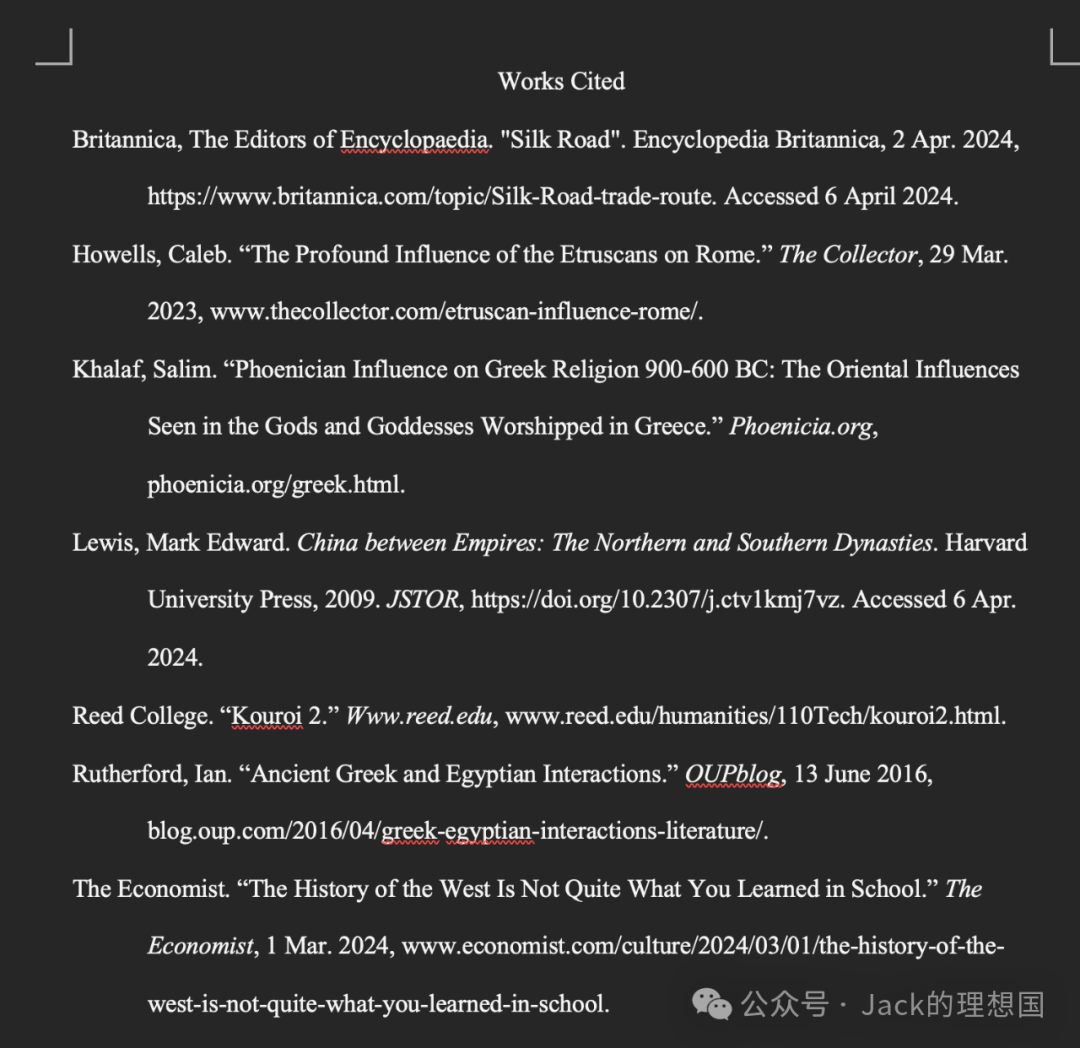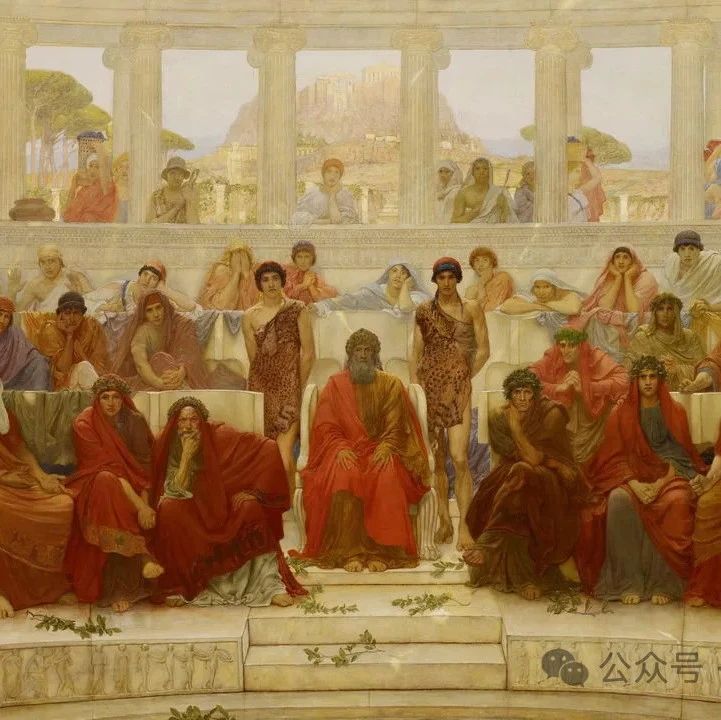Links Between East and West 57 Origin of Cultures 东西方的连接57 - 文化的起源
Many people exhibit a compartmentalized view of history. Different civilizations today have different ancestors that, due to various barriers, developed independently from each other. This view is especially prevalent in the West, where many point out that the ancient Greek and Roman cultures were the progenitors of Western civilization today. Some take great pride in the Greeks and Romans, claiming they were Western culture's sole founders. With a selection of examples, this essay will refute this view. It shall be argued that civilizations, even ancient ones, have rarely developed independently. What makes history is not just simply diverse global cultures but also the links they forge with one another.
The Greek culture, which began in the sixteenth century B.C.E. with the birth of the Minoan and Mycenaean civilizations, is widely regarded as the ultimate “stem” of Western society. There is a common notion that everything started with the Greeks – they were the inventors of the fundamental political, economic, and cultural values governing the Western world. However, while the Greeks made many significant contributions, their culture did not progress in isolation. Thus, it is more fitting to claim that the Western civilization today is not derived solely from the Greek one, as neighboring peoples impacted the Greeks themselves.
To examine this point in greater detail, consider some of the connections that the ancient Greeks shared. The Greeks were in frequent contact with the Egyptians. The New Kingdom of Egypt reached its apex during the sixteenth century B.C.E. Like the Greeks, the Egyptians were also becoming an international power, expanding its influence to Syria and the Levant. Through trading with the Egyptians, they placed their influence on Greek art and architecture. For example, the utilization of stone columns in Greek architecture was chiefly inspired by Egyptian prototypes. Analogously, Greek sculptors adapted many standard poses from Egyptian figurines and other sculptures. When archaeologists compare ancient Greek and Egyptian sculptures, they conclude that many Greek sculptures display a straight standing pose with the arms held rigidly at the sides, resembling Egyptian figurines. While historians subsequently documented ancient Greek architecture or art as vital and glorious aspects of their culture, the development of these facets was partially dependent on the Egyptians.
As a maritime power, the Greeks were also engaged with the Phoenicians – traders that dotted the Eastern Mediterranean coast. During the Minoans and Mycenaeans' era, the Greeks invented a writing system called Linear A and B. Unfortunately, this system faded from popularity with the decline of the Mycenaeans towards the end of the thirteenth century B.C.E. The Phoenicians were the “exporters” of a new alphabetical writing system that would be a cornerstone of modern Western writing. This example suggests that the development of Greek culture was not isolated. Instead, the establishment of links with other peoples fueled such innovative development.
Finally, many credit the Athenians as the inventors of democracy. The direct democracy model that the Athenians ran, people argue, was the prototype upon which the structure of Western states was built much later. However, new research by the historian Josephine Quinn suggests that other neighboring powers might have influenced Athenian democracy. Civilizations in modern-day Libya experimented with democracy earlier than the Athenians. Usually associated with dictator rule, even the Persians imposed democracy upon many conquered city-states. Being in such proximity to these states, the Athenians could have taken inspiration or exchanged ideas regarding the form of government through trade or warfare. As a nexus of the ancient Mediterranean world, Greece could not exhibit a culture that was not “stained” by elements of other surrounding civilizations.
Many argue that, like the Greeks, the Romans should be upheld as a sacred civilization. They should be regarded as the sole inventors of many pillars of modern society, such as the law code or complicated architectures. However, upon closer investigation, the Roman culture also developed while blending with other cultures. When Rome first emerged as a substantial power in the Apennine Peninsula, their immediate neighbor was the Etruscan civilization. The Etruscans heavily influenced the Romans. For instance, several distinctive Roman architecture characteristics, like the stone arch or cuniculus, were Etruscan inventions. Sporting events such as slave fighting or chariot racing were the first Etruscan traditions. Even the Roman religion had elements of Etruscan belief systems. What moderners believe as products of the ingenuity of the Romans might find their roots in the Etruscan culture. While the Romans subsequently subjugated the Etruscans via brute force, previous exchanges of culture had left their marks on the conquerors. These marks allowed the Romans to be inspired, innovate, and deliver an even more significant impact on their sphere of influence.
Another civilization that Rome engaged with was Carthage. Carthage dominated Northern Africa and the Iberian Peninsula until Rome conquered it following the three Punic Wars. Cultural mingling occurred as the Romans interacted with the Carthaginians mainly through warfare. Carthage brought a trading, mercantilist culture into Rome. The city-state was a significant nexus between Greek, Phoenician, Iberian, Italian, Nubian, and Libyan cultures. By conquering Carthage, Rome gained access to all the connections that Carthage established with the greater Europe and beyond. The Romans subsequently developed a sophisticated trade network both on land and sea. The fusion between the Roman and Carthaginian cultures promoted the former, attaching new cultural values as Rome grew its hegemony.
Following the expansion of its sphere of influence, Rome forged links with Eastern powers, namely Han China. The establishment of the Silk Road introduced silk to the Romans. This commodity from the East impacted the cultural ideas surrounding fashion, wealth, and social status. Silk became a symbol of wealth or high social status. To an extent, the silk trade with China strengthened the hierarchical structure of Roman society as the differences between social groups were more pronounced. Alongside economic trade, historians have surmised that there must have been intellectual exchanges. These exchanges might have left a mark on Roman philosophy, worldview, mathematics, astronomy, and many other fields. The Roman civilization illustrates, again, that civilizations do not emerge or progress independently. Every civilization’s elements may be born from interactions with different cultures.
Even ancient China, a land known for its cultural longevity and unity, did not develop in isolation. Some of the most prosperous times in Chinese history, such as the Sui and Tang Dynasties, emerged due to interactions with other cultures. Before the Sui Dynasty, China was in a period known as the era of the Northern and Southern Dynasties. During this time, northern nomadic cultures mingled with the central Han culture. It was a period marked by continuous warfare, chaos, cultural assimilation, and mutual inspiration. These interactions with the northern peoples led to the establishment of some cultural cornerstones that defined the prosperity of the Sui and Tang. For example, the Sui and Tang period hailed religious diversity. There was a mix of Buddhism, Taoism, and belief systems from the nomadic tribes. Previously, owing to a range of political factors, ancient China had not displayed a variety of religions. The social and religious intercourses during the Northern and Southern Dynasties promoted the relative flow and exchange of ideas.
This essayist believes that contact across cultures, often over long distances, has been the engine of human civilizational development. This argument is relevant today, especially to those who contend that history is passé and the world order should be based purely on exchanging hard, cold interests. This essay has shown that, apart from creating warfare, cultural protectionism is also unfeasible in an interconnected world, making it doubly wrong. If leaders still value cultural diversity or desire to guide humankind to make the right choices in an increasingly unpredictable future, they must recognize the importance of sharing cultural discourses at every level.

许多人认为,历史中的文明发展是“割裂的。”这样的观点认为,今天,不同的文明有着不同的祖先,由于各种障碍,它们各自独立发展。这种观点在西方尤其盛行,许多人指出,古希腊和古罗马文化是当今西方文明的祖先。有些人以希腊人和罗马人为豪,声称他们是西方文化的唯一奠基者。本文将选取一些例子,驳斥这种观点。文章认为,各种文明,即使是古代文明,也很少是独立发展的。创造历史的不仅仅是多样的全球文化,更是它们之间密不可分的联系。
随着米诺斯文明和迈锡尼文明的诞生,始于公元前 16 世纪的希腊文化被广泛认为是西方社会的终极 "源头"。人们普遍认为,一切都始于希腊人--他们是西方世界基本政治、经济与文化价值观的发明者。然而,虽然希腊人做出了许多重大贡献,但他们的文化并不是孤立发展的。因此,更恰当的说法是,今天的西方文明并非完全源自希腊文明,因为希腊人本身也受到了周边民族的影响。
为了更详细地研究这一点,我们可以考虑一下古希腊人与其他文化之间的一些共同联系。希腊人与埃及人接触频繁,埃及新王国在公元前 16 世纪达到其权力顶峰。与希腊人一样,埃及人也正在成为一个国际强国,并将其势力范围扩展到叙利亚与新月沃土。通过与埃及人的贸易,他们对希腊艺术和建筑产生了影响。例如,希腊建筑中石柱的使用主要受到埃及原型的启发。同样,当时的希腊雕塑家也从埃及雕像与其他雕塑中借鉴了许多标准姿势。考古学家在比较古希腊语古埃及雕塑时得出结论,许多希腊雕塑都是笔直站立,双臂僵直地放在两侧,这与埃及雕像的姿势极为相似。虽然历史学家随后将古希腊建筑或艺术作为其文化的重要和辉煌方面进行了记载,但这些方面的发展部分依赖于与埃及人之间的交流。
作为一个海上强国,希腊人还与腓尼基人有交往,他们是活动于地中海东岸的商人。在米诺斯与迈锡尼时代,希腊人发明了一种被称为线形 A 与线形 B 的书写系统。不幸的是,这种系统随着迈锡尼人在公元前 13 世纪末的衰落而逐渐消失。腓尼基人是新字母书写系统的 "输出者",而这种新字母书写系统将成为现代西方文字的基石。这个例子表明,希腊文化的发展并不是孤立的。相反,与其他民族建立联系推动了这种创新。
最后,许多人认为雅典人是民主的发明者。人们认为,雅典人实行的直接民主模式是后来西方国家结构的原型。然而,历史学家约瑟芬-奎恩(Josephine Quinn)的最新研究表明,雅典民主可能受到了其他邻国的影响。现代利比亚的文明比雅典人更早尝试民主。波斯人通常与独裁统治联系在一起,但他们却同时在许多被征服的城邦中实施民主制度。雅典人与这些国家或帝国相距如此之近,可能是通过贸易或战争获得了有关政府形式的灵感或交换了想法。希腊作为古代地中海世界的中心,其文化不可能不受周边其他文明的 "沾染"。
许多人认为,与希腊人一样,罗马人也应被奉为“神圣”的文明,他们应被视为现代文明许多支柱的唯一发明者,如法典或复杂的建筑。然而,细究起来,罗马文化也是在与其他文化交融的过程中发展起来的。当罗马在亚平宁半岛崛起之初,他们的近邻是伊特鲁里亚文明。伊特鲁里亚人在很大程度上影响了罗马人。例如,罗马建筑的几个显著特点,如石拱或排水沟,都是伊特鲁里亚人的发明;奴隶格斗与战车比赛等体育赛事最早也是伊特鲁里亚人的传统;甚至罗马宗教也有伊特鲁里亚信仰体系的元素。现代人认为是罗马人聪明才智的产物,可能就源于伊特鲁里亚文化。虽然罗马人后来通过蛮力征服了伊特鲁里亚人,但之前的文化交流在征服者身上留下了印记。这些印记让罗马人受到启发,不断创新,并给他们的势力范围带来了更大的影响。
罗马接触的另一个文明是迦太基。迦太基曾是北非和伊比利亚半岛最主要的强国,直到罗马在三次布匿战争后征服了它。罗马人与迦太基人的交往主要是通过战争,但也发生了文化交融。迦太基为罗马带来了贸易和重商主义文化。迦太基城邦本身就是希腊、腓尼基、伊比利亚、意大利、努比亚和利比亚文化的重要纽带。通过征服迦太基,罗马获得了迦太基与大欧洲及其他地区建立的所有联系,罗马人随后在陆地和海上建立了一个复杂的贸易网络。罗马文化与迦太基文化的融合促进了前者的发展,并随着罗马霸权的扩大而附加了新的文化价值。
随着势力范围的扩大,罗马与东方强国,即汉朝中国,建立了联系。丝绸之路的建立为罗马人带来了丝绸,这种来自东方的商品影响了围绕时尚、财富和社会地位的文化观念。丝绸成为富裕或高社会地位的象征。在某种程度上,与中国的丝绸贸易加强了罗马社会的等级结构,因为社会群体之间的差异更加明显。除经济贸易外,历史学家还推测,当时肯定还有知识交流,这些交流可能在罗马哲学、世界观、数学、天文学等许多其他类似领域留下了印记。罗马文明再次说明,文明不是独立产生或发展的,每种文明的要素都可能诞生于与其他文化的互动之中。
即使是以文化悠久和统一著称的古代中国,也不是孤立发展的。中国历史上一些最繁荣的时期,如隋唐,都是在与其他文化的互动中出现的。隋朝之前,中国处于南北朝时代。在这一时期,北方游牧文化与中原汉文化相互交融。这一时期战乱不断,但同时也是文化同化和相互启发的时期。这些与北方民族的互动奠定了隋唐繁荣的一些文化基石。例如,隋唐时期崇尚宗教多样性,佛教、道教和游牧部落的信仰体系在这里交融。在此之前,由于一系列政治因素,古代中国并没有展现出宗教的多样性。南北朝时期的社会和宗教交往促进了思想的相对自由流动和交流。
总之,本文作者认为,不同文化之间的接触,往往是远距离的接触,是人类文明发展的动力。这一论点在今天仍有现实意义,尤其是对那些认为历史已经过时,世界秩序应完全建立在冷冰冰的硬利益交换基础上的人而言。本文表明,文化保护主义除了制造战争之外,在一个相互联系的世界中也是不可行的,因此它是双重错误的。如果领导人仍然重视文化多样性,或者希望引导人类在越来越难以预测的未来做出正确的选择,他们就必须认识到在各个层面共享文化元素,提倡文化交流的重要性。
- 本文标签: 原创
- 本文链接: http://www.jack-utopia.cn//article/636
- 版权声明: 本文由Jack原创发布,转载请遵循《署名-非商业性使用-相同方式共享 4.0 国际 (CC BY-NC-SA 4.0)》许可协议授权










